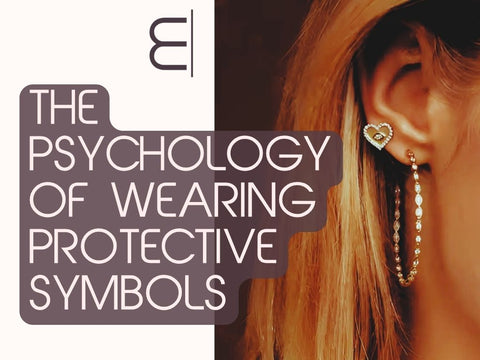For centuries, we've sought sacred symbols for comfort and strength. Ancient cultures knew the deep link between mind and spirit. Now, science shows how protective talismans work their magic.
Wearing symbols like amulets or charms changes your brain. They become anchors of confidence that shape your thoughts and feelings. Just touching a symbol can change your whole outlook.
Beliefs in protection talismans go beyond superstition. They meet our deep need for safety and control. Whether old charms or new jewelry, these symbols bridge our rational and intuitive sides.
In uncertain times, protective symbols offer comfort that crosses cultures. They remind us of our inner power and connect us to something bigger than us.
Key Takeaways
- Protective symbols activate psychological mechanisms that boost confidence and reduce anxiety
- Ancient wisdom and modern research both support the mental benefits of wearing meaningful talismans
- Spiritual symbolism creates powerful mind-body connections that influence daily emotions
- Protection beliefs fulfill universal human needs for security and personal empowerment
- Sacred symbols serve as psychological anchors during stressful or uncertain situations
- Wearing protective charms can shift mindset and enhance feelings of inner strength
Ancient Superstitions Meet Modern Mindset
Ancient civilizations knew something important about protection that we understand today. They left us with symbols that protect us, and these symbols are timeless. Now, we use these symbols in our own way, with a new understanding.
The connection between ancient superstitions and today's psychology is interesting. What our ancestors called spiritual protection, we now call emotional security. This shows how their wisdom is just as valuable today.
In our world, logic and intuition go hand in hand. You can believe in science and spiritual wisdom at the same time. This way, we can keep traditional practices while seeing their psychological value.
Turkish Nazar and Cross-Cultural Protection Beliefs
The Turkish Nazar is a well-known symbol of protection worldwide. Its blue eye design is part of cultural significance of evil eye beliefs in many places. It shows our universal need for protection.
Studies show that different cultures share similar beliefs in protection. Symbols like the Greek mati, Arabic ayn harsha, and Turkish nazar all protect us. They show how our psychological needs are the same everywhere.
The turkish nazar psychology works on many levels. It gives us comfort and connects us to our culture. It also makes us feel safe and secure, something we often miss in modern life.
These symbols are everywhere in our lives. We see them in jewelry, decorations, clothes, and more. They remind us of spiritual protection and are very important to us.
From Ancient Civilizations to Contemporary Fashion
Protective symbols have become fashion statements today. Ancient Egyptians used amulets for spiritual protection. Now, we wear similar symbols for both style and comfort.
This change doesn't mean we've lost their meaning. It shows how adaptable and resilient we are. People feel more confident and protected when they wear these symbols. Their psychological benefits are just as strong today.
Designers are now using protective symbols in creative ways. Luxury jewelry brands include evil eye designs with traditional stones. This makes protective jewelry popular and meaningful to more people.
The fashion world's use of protective symbols shows our desire for meaningful things. We want items that look good and have emotional value. This trend connects ancient wisdom with our modern lives.
Why Traditional Protective Jewelry Endures
Protective jewelry lasts because it meets basic human needs that never change. We always want to feel safe, connected, and meaningful. These symbols help us feel grounded in an uncertain world.
These symbols are appealing because they offer comfort without needing specific beliefs. You can enjoy their beauty and meaning, no matter your beliefs. This makes them accessible and meaningful to everyone.
Research confirms what ancient superstitions have always said: symbols can affect our minds and actions. Wearing protective jewelry boosts our confidence and reduces stress. This makes them even more relevant today.
Jewelry also has a physical benefit. It gives us a constant reminder of protection. This physical connection helps us stay emotionally balanced, even when things get tough.
We keep looking for these symbols because they offer something technology can't: a connection to our ancestors and spiritual protection. In our digital world, this connection to tradition is more valuable and necessary than ever.
The Psychology Behind Evil Eye Jewelry and Its Emotional Impact
Wearing protective symbols changes how we feel and think. They tap into our need for safety and control. This is a powerful psychological effect.
Studies show that symbols like the evil eye change our brain activity. They make us feel safer in uncertain times. It's not just superstition; it's real psychology.
Psychological Comfort from Amulets and Mental Well-being
Amulets offer comfort through our nervous system. Touching them calms us down. This is called "grounding," a way to feel stable again.
When we touch our jewelry, our brain releases chemicals that reduce stress. The evil eye pendant can make us feel more confident and centered. Many people feel more at ease when they wear it.
"The mind is everything. What you think you become. When we believe in protection, we create it within ourselves."
People who wear traditional protective jewelry may have lower stress levels. This leads to better sleep, focus, and emotional control. The jewelry reminds us of our inner strength.
Warding Off Negative Energy Through Symbolic Power
The idea of warding off negative energy works through our beliefs and awareness. Believing in our jewelry's power changes how we act. We stand taller, speak with confidence, and face challenges differently.
This mindset of protection changes how we see the world. It makes us feel safer and stronger. Negative situations seem less scary when we carry this mental shield.
The evil eye fights feelings of fear and vulnerability. It targets jealousy and ill-will, which can harm our mental health. Modern science confirms that perceived threats can stress us out.
Protective symbols stop these negative thoughts. They help us focus on our power instead of fear. This shift changes how we live and feel every day.
Social Connection and Cultural Identity Expression
Wearing protective jewelry connects us to others who believe the same. These bonds strengthen our sense of belonging and cultural identity. The symbols start conversations and build relationships.
Your jewelry tells a story about your values and heritage. Others recognize these symbols and feel a connection. This social aspect boosts the benefits of wearing protective pieces.
Community Belonging Through Shared Beliefs
Shared protective symbols create strong community bonds. Seeing someone else with an evil eye bracelet makes you feel connected. This recognition brings feelings of safety and acceptance.
Religious and cultural groups often focus on protective symbols. These shared beliefs create support networks that improve mental health. You're not alone in your spiritual journey; you're part of something bigger.
Being part of a community reduces anxiety and depression. The protective jewelry shows you belong to a supportive group. This connection helps you feel stable during tough times.
Personal Empowerment and Control
Protective jewelry gives you a sense of control over unpredictable situations. This feeling of empowerment reduces helplessness and increases resilience. You become an active participant in your own protection instead of a passive victim.
Choosing and wearing protective symbols shows self-care and intentionality. You're taking steps to improve your well-being. This proactive approach builds confidence and self-efficacy.
Personal empowerment through symbolic protection leads to lasting changes. You develop stronger coping mechanisms and emotional intelligence. The jewelry becomes a tool for personal growth and spiritual development.
Many people feel more decisive and assertive when wearing their protective pieces. The symbols remind you of your inner power and ability to overcome challenges. This psychological boost positively affects every area of your life.
The Deeper Meaning Behind Wearing Protection
Our ancestors knew something important about us that we need today. They used evil eye jewelry and talismans to connect our minds and hearts. These symbols help us feel safe and connected.
Wearing these symbols is a tradition that connects us to our past. It's not just about superstition. It's about feeling strong and protected through meaningful objects.
The real power of these symbols is in how they change our thinking. They remind us of our values and our place in the world. Touching your nazar pendant or cross brings you back to your purpose.
Explore these symbols with an open heart. Choose from Turkish evil eye beads, Celtic knots, or other symbols. Let them help you grow and find peace.
Your spiritual path is special, and these symbols can guide you. Learn from their wisdom and history. See how they can make your life more meaningful and connected.
FAQ
What is the psychology behind evil eye jewelry and why do people feel drawn to it?
Evil eye jewelry taps into our need for safety and control. It offers comfort and a sense of power. By wearing it, you connect with ancient wisdom, blending your rational mind with spiritual instincts.
How do protection talisman beliefs actually affect our mental well-being?
Beliefs in protection talismans boost our mental health through positive thinking and the placebo effect. They reduce anxiety and boost confidence. These symbols help us meditate and grow spiritually, turning everyday jewelry into powerful tools.
What is the cultural significance of evil eye jewelry across different societies?
Evil eye jewelry holds deep meaning across cultures, from Turkey to the Mediterranean. It speaks to our universal need for safety. Wearing it connects you to your heritage and builds bonds with others who share your beliefs.
Why do ancient superstitions like the evil eye, even in modern times?
Ancient superstitions like the evil eye remain relevant today. They meet timeless psychological needs, even with modern advancements. These symbols offer comfort and confidence, linking our past to our present.
How does wearing protective jewelry create psychological comfort from amulets?
Protective jewelry gives us a sense of control and connection to spiritual energy. It reminds us of our strength and serves as a focus for positive intentions. This boosts our sense of security and spiritual practice.
What role does the Turkish Nazar psychology play in modern protective jewelry?
The Turkish Nazar shows how old traditions meet modern needs. It's a symbol of protection that has stood the test of time. Its popularity shows how ancient wisdom fits into today's spiritual and fashion trends.
How does traditional protective jewelry help with warding off negative energy?
Traditional jewelry creates barriers against negative energy. It acts as a shield, deflecting harm and attracting good. Believing in its power boosts our confidence and energy.
What is the spiritual symbolism behind evil eye jewelry?
Evil eye jewelry symbolizes protection and divine watchfulness. It reflects harmful intentions back and reminds us of our spiritual connection. It helps us stay aware and maintain our spiritual boundaries.
How do protective symbols create social connection and community belonging?
Protective symbols bring people together through shared beliefs. They create bonds and reinforce cultural identity. Wearing them connects you to a global community that values spiritual protection.
Can wearing evil eye jewelry actually provide personal empowerment and control?
Yes, evil eye jewelry empowers and gives you control. It reminds you of your inner strength and ability to protect yourself. It turns you into an active participant in your spiritual well-being, boosting your confidence and sense of agency.



